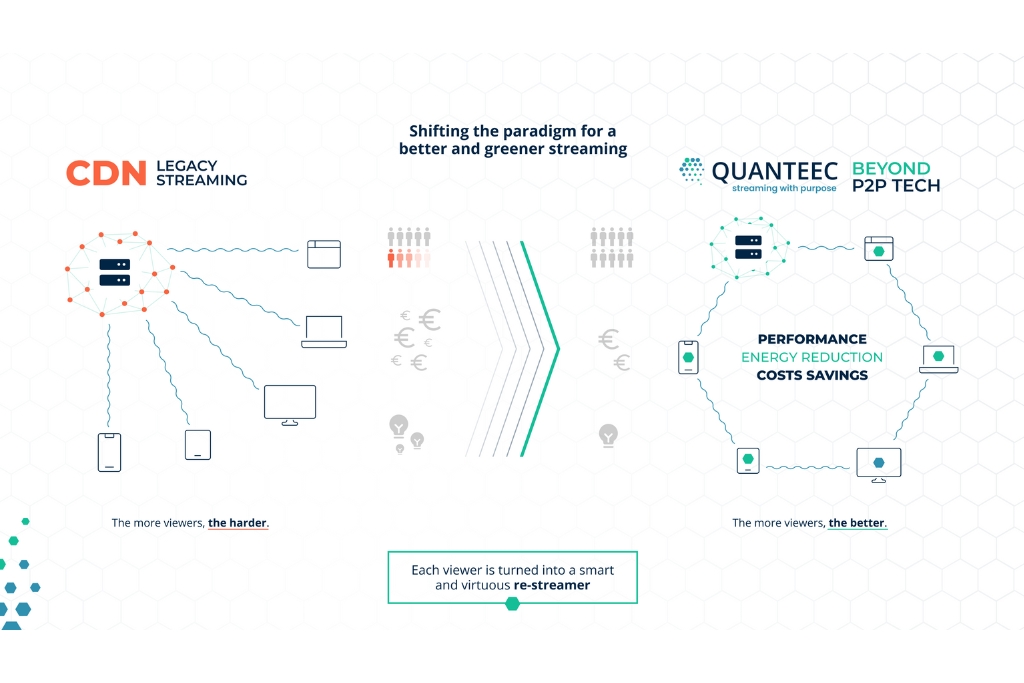Peer-to-peer is being proposed as a solution for streaming services to overcome capacity bottlenecks and cope with rapid scaling during live events while keeping CDN costs and energy consumption down. Quanteec will be at IBC in September with claims that its next-generation, CDN-agnostic P2P streaming solution can reduce energy consumption by up to half and reduce costs by at least one-quarter compared to a CDN-only solution. 70% offload (removal from CDN throughput) is possible for live streams, the company says.
Major broadcasters have been implementing the Quanteec technology in anticipation of major sporting events this summer. The P2P streaming solution uses its decentralized model to complement CDNs and relies on a software add-on to the video player on receive devices so they can become what Quanteec calls “smart and virtuous re-streamers” to other viewing devices.
The technology can be used to feed Smart TVs, laptops, tablets, etc., and the vendor claims there is no noticeable impact on user experiences. “We have cut the time it takes to stream video between viewers to milliseconds,” it says, while providing a long list of ultra-low latency schemes it supports, including CMAF, LL-DASH and LL-HLS. The company is promising to showcase sub-two-second overall latency using P2P streaming at IBC.
Quanteec P2P supports AV Player for Apple TV, LG WebOS, Amazon Fire TV, Samsung SMARTV and Android TV, and web players like Brightcove, Bitmovin and Theoplayer among many others. The solution also supports client-side and server-side dynamic ad insertion.
“Peaks in viewership that might be associated with major live events don’t have to rely on CDN capacity. In fact, transmission becomes easier as more users log on to the ‘broadcast’,” Quanteec explains. “This contrasts sharply with traditional CDN use in which streaming capacity has to be signed off before an event in anticipation of the expected peak traffic, alongside some over-provisioning as a fail-safe.”

This technology was designed with sustainability firmly in mind and energy savings are one of the KPIs that can be logged (helpful for anyone looking for carbon reduction targets with auditing). This environmental impact data can be split across each event, client or even viewer and provided in real-time.
Daniel Négru, Co-founder and CEO at Quanteec, says: “We want to show broadcasters – especially the sustainability champions – that delivering big events to large numbers of viewers can be achieved in a better, cheaper and greener way. We launched in 2021 to address two problems with streaming live events – how to handle traffic peaks without deploying more and more servers, and how to make streaming more sustainable.”
At IBC, Quanteec will showcase plug-ins and data that broadcasters can deploy to allow individual viewers to track and engage with their own energy footprint – “increasing user engagement and inviting viewers to be collaborators in sustainable practice.”
Quanteec is a contributor to one of the IBC Accelerator Project 2024 entries: Ecoflow. Ecoflow stands for ‘Energy-Conserving Optimization for Future-Ready Low-Impact Online Workflows’ and is supported by the BBC, ITV, EBU and RTL Netherlands. The project tackles the environmental impact of broadcasting by developing metrics for energy consumption at major steps along the video delivery supply chain.

